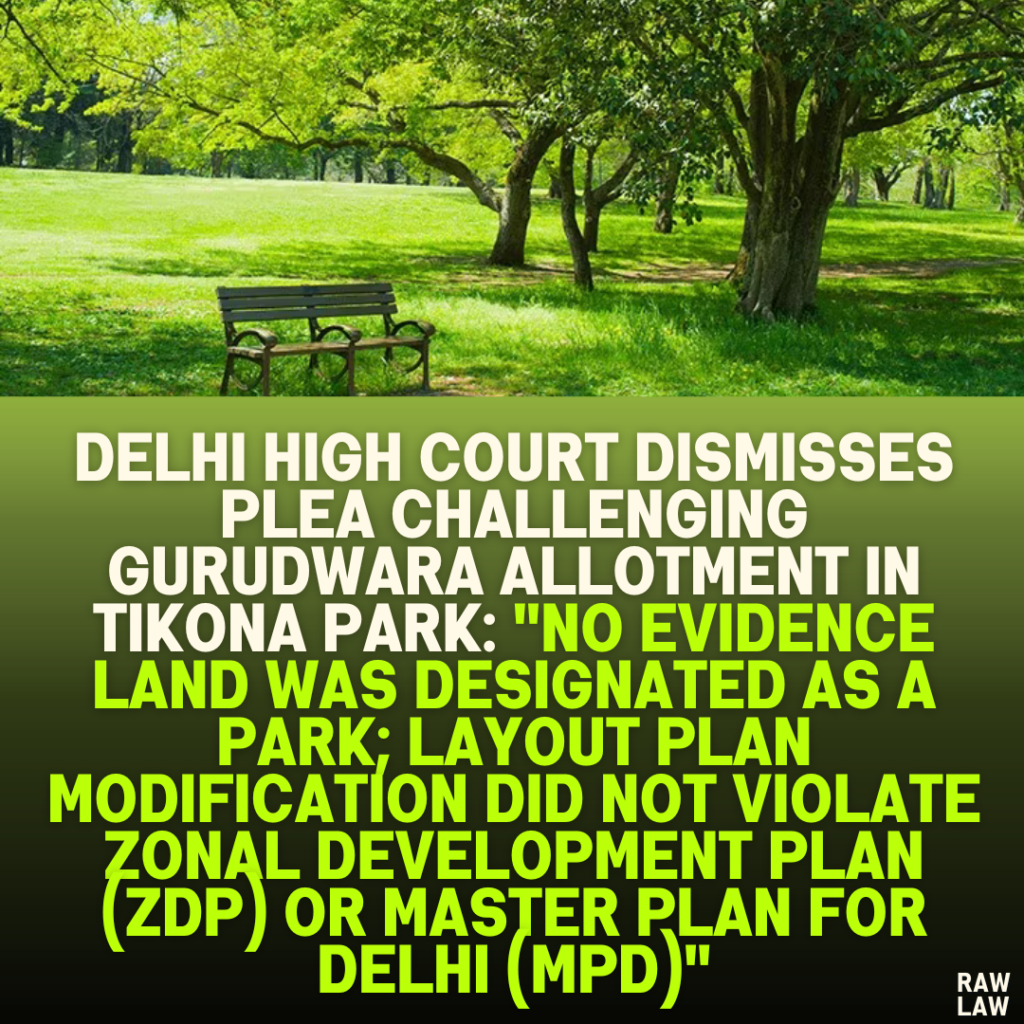Court’s Decision
The Delhi High Court dismissed the writ petition challenging the allocation of a portion of land in Tikona Park, Sheikh Sarai Phase-I, New Delhi, to construct a Gurudwara. It concluded that there was no evidence that the land was ever classified, designated, or used as a green area or park under the provisions of the Delhi Development Act, 1957, or the Master Plan for Delhi 2021 (MPD 2021).
The court held that the layout plan modification for the religious site did not violate the Zonal Development Plan (ZDP) or the MPD. Consequently, the petitioner’s claims of illegal allotment and violation of rights were deemed baseless.
Facts
- Petitioner’s Grievance:
- The petitioner was a long-term resident of the area.
- She alleged that the Delhi Development Authority (DDA) arbitrarily allocated a part of Tikona Park to a religious society for constructing a Gurudwara.
- She claimed that this violated her rights under Article 21 of the Constitution, which guarantees the right to a healthy environment.
- She also argued that the allotment contravened the Delhi Development Act, 1957.
- Respondents’ Stand:
- The DDA and other respondents claimed that the land was not a designated park or green area but a vacant dumping ground.
- The Gurudwara Society emphasized the lack of religious facilities for the Sikh community in the neighborhood.
- The Municipal Corporation of Delhi (MCD) demonstrated efforts to maintain the remaining park area.
Issues
- Whether the land allotted for religious purposes was designated as a green area or park under the MPD 2021 or ZDP?
- Whether the DDA followed proper procedures in modifying the layout plan?
- Did the allotment violate public interest or the petitioner’s constitutional rights?
Petitioner’s Arguments
- The petitioner contended that the land was marked as a green area in the MPD and ZDP.
- She alleged that the DDA misrepresented facts and violated procedures by allocating a green area for a concrete structure.
- She submitted that several RTI applications seeking transparency were met with misleading responses.
- The petitioner relied on various precedents, arguing that public parks and green spaces are protected and cannot be diverted for other uses.
Respondents’ Arguments
- Delhi Development Authority (DDA):
- Argued that the layout plan modification was conducted lawfully under its powers.
- Stressed that the ZDP and MPD allowed religious sites in residential zones.
- Denied that the site was ever categorized or used as a green area.
- Asserted that adequate green spaces remained available in the vicinity.
- Gurudwara Society:
- Highlighted that the local Sikh community lacked any Gurudwara in the area.
- Submitted that the land was previously a barren dumping ground and not a functional park.
- Justified the allotment based on public interest and community needs.
- Municipal Corporation of Delhi (MCD):
- Submitted evidence, including photographs, to show that the remaining park area was well-maintained and green.
Analysis of the Law
- Provisions of the Delhi Development Act, 1957:
- The court examined Sections 7, 8, and 9 of the Act, which outline the civic survey, master plan, and zonal development plans for Delhi.
- These provisions allow layout plan modifications if they conform to the MPD and ZDP.
- Distinction Between Layout Plans and Zonal Development Plans:
- The court clarified that a layout plan is a subdivision plan indicating specific uses for plots, while a ZDP operates at a broader level.
- It held that layout plans can be administratively modified without invoking Section 11A of the Act, provided they align with the MPD and ZDP.
- Compliance with MPD 2021:
- The court found that the allotment did not require amendments to the MPD or ZDP and was consistent with their provisions.
Precedent Analysis
- Distinction from Past Cases:
- In earlier cases, such as Dr. G.N. Khajuria v. DDA, land designated as a park was unlawfully diverted, which violated public interest. In this case, no evidence showed that the land was designated or used as a green area.
- Supportive Precedents:
- The court referred to MG Ramachandran v. MCD, where it was held that layout plans can be revised for public interest if done lawfully.
- Conclusion on Precedents:
- The petitioner’s reliance on precedents was deemed misplaced, as the facts did not align with the present case.
Court’s Reasoning
- Land Status:
- The court found no evidence that the land was ever a green area or part of a designated park.
- The site was a dumping ground with no significant trees or green cover.
- Procedure Compliance:
- The layout plan modification adhered to the DDA’s powers and the MPD 2021.
- Public Interest:
- The court noted that the allotment served public interest by addressing the religious needs of the local Sikh community without sacrificing larger public interest.
Conclusion
The court dismissed the writ petition, holding that:
- The land in question was never designated as a green area or park.
- The DDA’s actions conformed to the MPD 2021 and ZDP.
- The petitioner’s allegations of procedural violations and public interest concerns were unsubstantiated.
All pending applications were also disposed of.
Implications
- Policy Validation:
- The judgment affirms the DDA’s authority to modify layout plans in compliance with broader development goals.
- It clarifies that such modifications do not necessarily violate public interest.
- Precedent for Future Cases:
- The ruling distinguishes between layout plans and ZDPs, providing a clear framework for future disputes.
- Community Impact:
- The decision underscores the balance between development and public interest, prioritizing community needs while ensuring compliance with planning laws.



